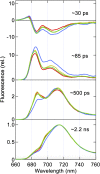LHCSR1-dependent fluorescence quenching is mediated by excitation energy transfer from LHCII to photosystem I in Chlamydomonas reinhardtii
- PMID: 29555769
- PMCID: PMC5889656
- DOI: 10.1073/pnas.1720574115
LHCSR1-dependent fluorescence quenching is mediated by excitation energy transfer from LHCII to photosystem I in Chlamydomonas reinhardtii
Abstract
Photosynthetic organisms are frequently exposed to light intensities that surpass the photosynthetic electron transport capacity. Under these conditions, the excess absorbed energy can be transferred from excited chlorophyll in the triplet state (3Chl*) to molecular O2, which leads to the production of harmful reactive oxygen species. To avoid this photooxidative stress, photosynthetic organisms must respond to excess light. In the green alga Chlamydomonas reinhardtii, the fastest response to high light is nonphotochemical quenching, a process that allows safe dissipation of the excess energy as heat. The two proteins, UV-inducible LHCSR1 and blue light-inducible LHCSR3, appear to be responsible for this function. While the LHCSR3 protein has been intensively studied, the role of LHCSR1 has been only partially elucidated. To investigate the molecular functions of LHCSR1 in C. reinhardtii, we performed biochemical and spectroscopic experiments and found that the protein mediates excitation energy transfer from light-harvesting complexes for Photosystem II (LHCII) to Photosystem I (PSI), rather than Photosystem II, at a low pH. This altered excitation transfer allows remarkable fluorescence quenching under high light. Our findings suggest that there is a PSI-dependent photoprotection mechanism that is facilitated by LHCSR1.
Keywords: algae; fluorescence; light; photosynthesis; stress.
Conflict of interest statement
The authors declare no conflict of interest.
Figures





Similar articles
-
LHCSR3 is a nonphotochemical quencher of both photosystems in Chlamydomonas reinhardtii.Proc Natl Acad Sci U S A. 2019 Mar 5;116(10):4212-4217. doi: 10.1073/pnas.1809812116. Epub 2019 Feb 19. Proc Natl Acad Sci U S A. 2019. PMID: 30782831 Free PMC article.
-
Excitation energy transfer in Chlamydomonas reinhardtii deficient in the PSI core or the PSII core under conditions mimicking state transitions.Biochim Biophys Acta. 2016 Jun;1857(6):625-33. doi: 10.1016/j.bbabio.2016.03.002. Epub 2016 Mar 3. Biochim Biophys Acta. 2016. PMID: 26946087
-
Interaction between the photoprotective protein LHCSR3 and C2S2 Photosystem II supercomplex in Chlamydomonas reinhardtii.Biochim Biophys Acta Bioenerg. 2017 May;1858(5):379-385. doi: 10.1016/j.bbabio.2017.02.015. Epub 2017 Mar 1. Biochim Biophys Acta Bioenerg. 2017. PMID: 28257778
-
Novel insights into the function of LHCSR3 in Chlamydomonas reinhardtii.Plant Signal Behav. 2015;10(12):e1058462. doi: 10.1080/15592324.2015.1058462. Plant Signal Behav. 2015. PMID: 26237677 Free PMC article. Review.
-
Structural analysis and comparison of light-harvesting complexes I and II.Biochim Biophys Acta Bioenerg. 2020 Apr 1;1861(4):148038. doi: 10.1016/j.bbabio.2019.06.010. Epub 2019 Jun 20. Biochim Biophys Acta Bioenerg. 2020. PMID: 31229568 Review.
Cited by
-
In vitro and in vivo investigation of chlorophyll binding sites involved in non-photochemical quenching in Chlamydomonas reinhardtii.Plant Cell Environ. 2019 Aug;42(8):2522-2535. doi: 10.1111/pce.13566. Epub 2019 May 9. Plant Cell Environ. 2019. PMID: 30997927 Free PMC article.
-
Regulation of Microalgal Photosynthetic Electron Transfer.Plants (Basel). 2024 Jul 29;13(15):2103. doi: 10.3390/plants13152103. Plants (Basel). 2024. PMID: 39124221 Free PMC article. Review.
-
LHC-like Proteins: The Guardians of Photosynthesis.Int J Mol Sci. 2023 Jan 28;24(3):2503. doi: 10.3390/ijms24032503. Int J Mol Sci. 2023. PMID: 36768826 Free PMC article. Review.
-
Small RNA-mediated silencing of phototropin suppresses the induction of photoprotection in the green alga Chlamydomonas reinhardtii.Proc Natl Acad Sci U S A. 2023 May 2;120(18):e2302185120. doi: 10.1073/pnas.2302185120. Epub 2023 Apr 25. Proc Natl Acad Sci U S A. 2023. PMID: 37098057 Free PMC article.
-
Microsecond and millisecond dynamics in the photosynthetic protein LHCSR1 observed by single-molecule correlation spectroscopy.Proc Natl Acad Sci U S A. 2019 Jun 4;116(23):11247-11252. doi: 10.1073/pnas.1821207116. Epub 2019 May 17. Proc Natl Acad Sci U S A. 2019. PMID: 31101718 Free PMC article.
References
-
- Horton P, Ruban AV, Walters RG. Regulation of light harvesting in green plants. Annu Rev Plant Physiol Plant Mol Biol. 1996;47:655–684. - PubMed
-
- Niyogi KK, Truong TB. Evolution of flexible non-photochemical quenching mechanisms that regulate light harvesting in oxygenic photosynthesis. Curr Opin Plant Biol. 2013;16:307–314. - PubMed
-
- Derks A, Schaven K, Bruce D. Diverse mechanisms for photoprotection in photosynthesis. Dynamic regulation of photosystem II excitation in response to rapid environmental change. Biochim Biophys Acta. 2015;1847:468–485. - PubMed
-
- Li XP, et al. A pigment-binding protein essential for regulation of photosynthetic light harvesting. Nature. 2000;403:391–395. - PubMed
Publication types
MeSH terms
Substances
LinkOut - more resources
Full Text Sources
Other Literature Sources
Molecular Biology Databases

